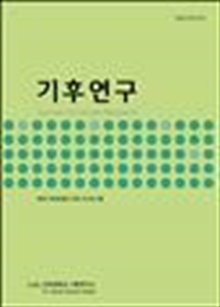간행물
기후연구 KCI 등재 Journal of Climate Research

- 발행기관 건국대학교 기후연구소
- 자료유형 학술지
- 간기 계간
- ISSN 1975-6151 (Print)2288-8772 (Online)
- 수록기간 2006 ~ 2021
- 주제분류 사회과학 > 지리학 사회과학 분류의 다른 간행물
- 십진분류KDC 453DDC 551
권호리스트/논문검색
제13권 제1호 (2018년 3월) 5건
1.
2018.03
서비스 종료(열람 제한)
This study aims to analyze the frequency of Asian dust occurrences and the factors related to dust rises in the source region using the MODIS Land Cover data, WMO SYNOP data, and climate index data. All dust rise cases at sites which experienced more than 20 time dust rise events during the 21 years from 1997 to 2017 are analyzed. The most frequent dust rise occurred over the barren region followed by grasslands and croplands. It is found that the frequency of Asian dust events is positively correlated with the number of days on which wind speed exceeds the threshold value. It is also found that the number of days over the threshold wind speed in the barren region is negatively correlated with the wintertime North Atlantic Oscillation (NAO) and that the number of days over the threshold wind speed in grassland is negatively correlated with the El Niño/Southern Oscillation (ENSO) in spring.
2.
2018.03
서비스 종료(열람 제한)
The interannual variability of summer temperature during June-August (JJA) in South Korea was associated with geopotential height averaged in the East Sea (Korea-Japan Index, KJI) and in the subtropical western North Pacific (Western North Pacific Subtropical High Index, WNPSHI). The KJI was coupled with a decaying El Niño one month in advance, while the WNPSHI was influenced by Sea Surface Temperature (SST) anomaly in the western North Pacific and a developing El Niño one to three months ahead. Additionally, the JJA temperature over South Korea was affected by SST anomaly in the western North Pacific in May. Based on these teleconnections, a multivariate regression model using the SST surrogates for the KJI and WNPSHI and an univariate model using an area-averaged May SST were developed to reconstruct the JJA temperature over South Korea. Both of the empirical models reproduced the JJA and monthly temperatures reasonably well. However, when the simulated SSTs from global climate models were used, the multivariate model outperformed the univariate model. Further, for JJA temperature prediction, the multivariate model with 6-month lead SST outstripped one-month lead prediction of global climate models. Therefore, the empirical-dynamical approach can pave a promising way for summer temperature prediction in South Korea.
3.
2018.03
서비스 종료(열람 제한)
This study used a quantile regression model and a non-homogeneous regression model to calibrate probabilistic forecasts of wind speed. These techniques were applied to the forecasts of wind speed over Pyeongchang area using 51-member European Centre for Medium-Range Weather Forecast (ECMWF). Reliability analysis was carried out by using rank histogram to identify the statistical consistency of ensemble forecasts and corresponding observations. The performances were evaluated by rank histogram, mean absolute error, root mean square error and continuous ranked probability score. The results showed that the forecasts of quantile regression and non-homogeneous regression models performed better than the raw ensemble forecasts. However, the differences of prediction skills between quantile regression and nonhomogeneous regression models were insignificant.
4.
2018.03
서비스 종료(열람 제한)
This study investigates the simulation skills of RegCM4 for Diurnal Variations (DV) of temperature and precipitation over South Korea according to the Lateral Boundary Conditions (LBCs) using two sets of 30-yr (1981-2010) integration with two LBCs (RG4_HG2: HadGEM2-AO and RG4_ EH6: EHCAM6). In general, RegCM4 successfully reproduces the DV of temperature irrespective of LBCs and seasons. The DV of temperature is well captured in the coastal region compared to that over inland area irrespective of LBCs and season although the magnitude of DV is underestimated. However, it fails to simulate the early morning peak of precipitation irrespective of LBCs, in particular, for summer and autumn although it captures the late afternoon peak over the inland region. And the impacts of LBCs on the simulation skills of RegCM4 for the DV of precipitation are more prominent during summer than other seasons. As a result, the simulation skill of RG4_HG2 for the DV of temperature is better than RG4_ EH6, but the simulation skill for the DV of precipitation is opposite. In general, the impacts of LBCs on the simulation skills for the DV of temperature and precipitation of RegCM4 are different according to the season, time and geographic location.
5.
2018.03
서비스 종료(열람 제한)
In this study we evaluated the performance of the PRIDE (PRISM based Dynamic downscaling Error correction) model version 2.0 to provide user groups with model performance for daily temperature and daily precipitation using 54 observation station data and Regional Climate Model (RCM) HadGEM3- RA data for 30 years from 1981 to 2010. As a result of the verification of the independent period, the PRIDE model was found to effectively correct the systematic error of the RCM. This was because the PRIDE model basically calculated seasonal cycle of daily time scale using observational grid data produced based on PRISM (Parameter-elevation Relationships on Independent Slopes Model) and used PRISM to replace seasonal cycle of the RCM. As a result of the verification by quantitative measures, the temperature simulated by the PRIDE model showed a 56% to 80% reduction in the systematic error of the RCM on average. The precipitation simulated by the PRIDE model showed a reduction of the systematic error of the RCM by about 41%. The PRIDE model reproduced the bi-modal peak of summer precipitation, but RCM did not simulate well. As a result of analyzing the histogram, the PRIDE model was found to improve the temperature characteristics of the RCM, which simulated less frequently than the observations, at a high temperature interval. The rainfall simulated by the PRIDE model reduced the error of the number of days of precipitation simulated by the RCM by about 43% and also reduced the error by about 46% in light precipitation days.

